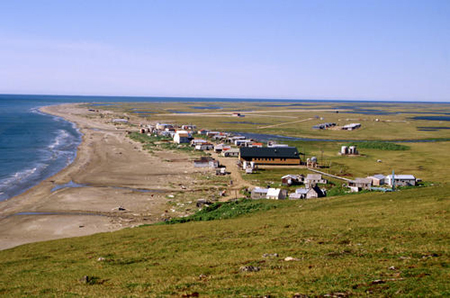
Of Wales and Wind Power
Diesel generators provide electrical power for more than 180 Alaska villages. With diesel fuel costs rising, more villages may go the way of Wales someday soon.
Wales is a village of 160 people on the tip of the Seward Peninsula where energy scientists and two Alaska electric cooperatives have supplemented diesel power with one of the area’s greatest natural resources, wind.
The wind blows year-round at Wales, which juts into the Bering Sea northwest of Nome and southwest of Kotzebue. The average wind speed at Wales is about 18 miles per hour, which is why engineers from the National Renewable Energy Laboratory and local power companies chose it as one of several coastal villages to outfit with wind/diesel technology. Kotzebue, St. Paul Island, and Selawik also supplement diesel with wind power or have plans to do it soon.
Mari Shirazi is an engineer with the National Renewable Energy Laboratory in Boulder, Colorado. She has worked on the Wales project since 1996.
Diesel is king in the villages and it will be for the near future, Shirazi said. For all the headaches and cost of transporting diesel fuel by barge and storing it in tanks that sometimes leak, the diesel generator is still a reliable way to create electricity in a remote setting. The challenge for Shirazi and other engineers is to supplement the diesel generators with renewable energy sources without compromising power reliability and quality.
Fuel prices will continue to rise in the Bush, and state legislators have not fully funded Alaska’s Power Cost Equalization program for the past three fiscal years. The Power Cost Equalization program subsidizes the cost of energy for rural communities. In Wales, for example, power recently cost 41 cents per kilowatt-hour to generate. The program kicked in 19 cents toward that, and residents paid 22 cents per kilowatt-hour. Customers connected to large power grids in the Anchorage and Fairbanks areas paid about 10 cents per kilowatt-hour as of mid-February 2004.
The Wales wind/diesel hybrid system became operational in March 2002, after technicians and engineers from Kotzebue Electric Association installed two wind turbines that sit on 75-foot towers outside the village of Wales.
The wind/diesel system had one of its best months in August 2002, when the wind turbines provided enough electricity that the diesel generators shut themselves off for several days.
“When Wales is working at its best, the wind turbines can supply 40 percent of the village’s energy per year,” Shirazi said. “And 20 percent of the time you don’t have to have the diesel running at all.”
Keeping the wind/diesel system running has been difficult due to the remoteness of Wales and other issues that arise when trying a new technology.
“When things break, they may not get fixed for a long time,” Shirazi said.
Despite the maintenance problems at Wales, wind and hydroelectric projects have encouraged engineers to continue the search for alternative sources of energy. Many researchers, including some at the University of Alaska, are working on fuel cells that may someday find a home in Alaska villages.
Rising fuel prices will probably be the driver for the change from diesel-only systems. The Alaska Village Electric Cooperative once tallied up the amount of diesel used to run 144 generators in villages, finding the amount burned each year would keep a diesel truck running for 900 laps around the world.
On another energy-related topic, Jim Lokken of Fairbanks told me that a hockey player could not burn 6,000 calories in one hour, an amount I found in the book, the Physics of Hockey. About 1,800 calories is a more realistic number, said Lokken, who earned a graduate degree by studying the energy consumption and output of athletes.





